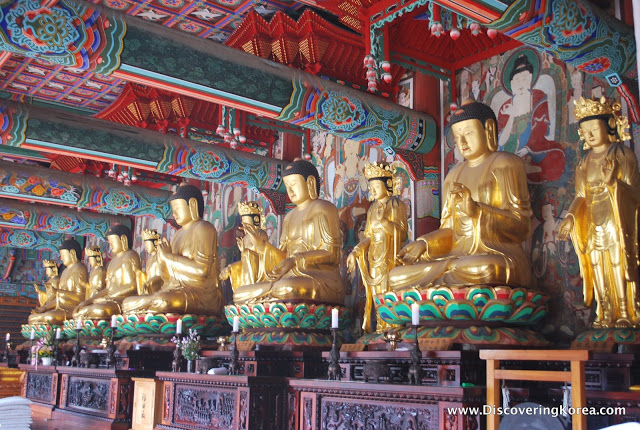Until a couple of weeks ago, I had never visited North Jeolla Province. So when a friend of mine invited me to come along with her on a weekend trip, I jumped at the chance.

North Jeolla-do has long been Korea’s rice bowl, and its terraced rice paddies and natural areas are famed for their beauty. During my travels there, one of my favorite places was the GeumsansaGold Mountain Temple.
“Geumsansa” actually means “Gold Mountain Temple,” and it’s technically located between the cities of Jeonju (전주시) and Gimje (김제시) on the slopes of Moaksan mountain (모악산).

Founded over 14 centuries years ago during the first year of King Beop (법왕) of the Baekje Kingdom, the temple is best known for its Maitreya Hall, which houses the massive Mireuksa Buddha, and is Korea’s only remaining 3-story pre-modern building.
The gorgeous structure features dozens of colorful paintings. And each corner of its three roofs requires a supporting column, due to the weight of the ornate eaves.

Legend has it that the temple was built after Master Jinpyo 진표 had a vision of a Maitreya Buddha upon returning from China.
After the vision, he met a dragon king who presented him with a jade robe and led him into the forest. Suddenly, men and women appeared and came together to build the temple in just a few days.
By the year 1097 during Korea’s Goryeo Dynasty, the Geumsansa Gold Mountain Temple complex had grown to 86 shrine halls and 43 hermitages.

This golden age for the GeumsansaGold Mountain Temple ended, however, during the Hideyoshi invasions of the late 16th century. During the Japanese invasions, Geumsansa was a training ground for over 1,000 monks who volunteered to fight against the intruders. In response, the entire complex was razed by fire by the Japanese.
Many of Geumsansa Gold Mountain Temple‘s present buildings date from 1635, although there are several stone treasures that predate them. For example, Sokryeondae (석련대), a detailed lotus-shaped pedestal cut from a solid piece of stone, is estimated to be over 1,000 years old.

The pedestal, the 3-story hall, a number of other buildings, stone treasures and even a few ancient trees surround a large peach-colored courtyard. When I visited early one Saturday morning, I was struck by the temple’s peaceful setting. The beautiful buildings amongst forested hills and between two streams felt perfect.

There’s no doubt that this is why Geumsansa Gold Mountain Temple has a popular temple stay program. Guests help with chores, practice sitting and walking meditation, and even participate in formal monastic meal and tea ceremonies.
If you plan on spending the night, however, you should know that the pre-dawn morning service begins at 3:00 am, when the rhythmic sounds of a mokt’ak and chanting signal it’s time to file into the Main Buddha Hall. For you late sleepers out there, please note that participation is not optional!

When it was time to leave and I had passed through the last of the four gates leading into Geumsansa Gold Mountain Temple, I saw a number of red flowers that had popped up near the gate’s base.
The best way I can describe them is a thin stalk topped off with what resembles a dozen bright red, tiny Asiatic lilies. It turns out these are hurricane or red spider lilies, and they’re one of the most colorful blossoms of Fall.
For Your Information…
| Open: | Sunrise-Sunet |
| Admission Price: | ₩3,000 Adults; ₩2,000 Youth; ₩1,000 Children; |
| Address: | North Jeolla Province Gimje-si Geumsan-myeon Maok 15-gil 1 |
| Directions: | From Jeonju Express Terminal, take bus #79 to Geumsansa Temple (buses depart every 30 mins. between 06:24~22:45). |
| Phone: | 63-1330 |
| Website: | Official Site |
About Matt Kelley
Matt Kelly is native of the US Pacific Northwest and is half-Korean by ethnicity. He lived in Korea for five years and has written hundreds of travel guides for Wallpaper, TimeOut, the Boston Globe and Seoul Magazine and was a host for several different variety shows on Korean radio and television.
